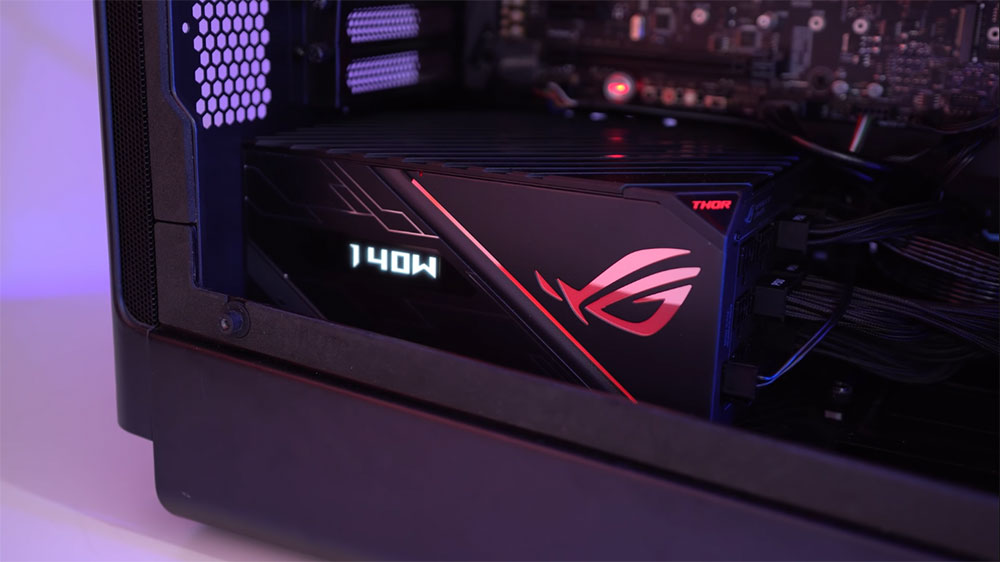The Asus ROG Thor is a very cool looking power supply that shows real-time energy consumption on its built-in screen. It’s inaudible, fully modular, and looks absolutely fantastic. But ultimately it’s $200, a crazy amount of money that most people would never dream of spending on a power supply.
As you’d expect for such a beefy unit, the box is very heavy and inside you’ll find the power supply itself and all the cables you’ll need to get started. The power supply is very well built and while it’s rather large it’s not too overbearing.
The OLED screen rests upon the left-hand side of the unit which does mean that you’ll have to have the PSU fan facing up in a large majority of cases. This shouldn’t be an issue though as ROG claimed to have upgraded the heat sinks to produce up to 20% lower temperatures than the competition. Which I would take with a fair pinch of salt but in fairness. I was actually never able to hear the power supply in my somewhat limited testing.
Each of the visible cables is individually sleeved so the 4 PCIe, 2 CPU and single ATX power connections, all have that real premium look out of the box. But the Molex, SATA, and spare PCIe cables have a more standard plastic look.
In order to get the RGB to function, you’ll first need to hook this up to an addressable header on your motherboard and then sync it with Aura, Mystic light or whatever lighting system comes with your board. You don’t have to do this but otherwise, the lighting will be solid red and this is perhaps one of the bigger issues I have with this power supply.
Not the RGB lighting, I’m talking more about the lack of any connection to your PC over USB. And as such, you can’t control the lighting or get any of those readouts recorded in the software. And obviously I understand that the OLED screen works in real time so it’s not a huge issue but surely at this price, it’s something that should have been implemented.
Regardless, the build process is very simple. The only thing you’re gonna have to bear in mind is the case size, as you will need a longer PSU tray for this to fit. And in some smaller ATX cases, you may need to remove a hard drive cage while ITX and M-ITX options could be a no-go completely.
Assuming you pick the right case though that can properly show it off, the end result will look great. Having a real-time wattage value of AC power draw is something that’s completely new to me, and it’s really fascinating to watch this dial as you open and close programs.
It’s quite funny that even with an overclocked i7 and GTX 1080 TI, usage never topped 400 watts. So it’s clear that most users will be fine opting for the cheaper 850-watt variant if you’re running a normal system.
Having said this though it’s disappointing that it’s only the power draw that can be shown on the screen. Obviously, that is the main thing you’d want to display in the fact that is real times great but it would have been nice to have like a toggle switch so that we can see statistics over time. maybe our average power draw, temperatures, things like that.
And once again if you have that USB connectivity, I’m sure you’d be a cycle through other stuff like you can on ROG’s Ryuo coolers.
What you’re getting with the Thor then is a seriously well-built Platinum power supply that’s equipped to take on pretty much any PC and comes back with a 10-year warranty. Except that the screen and RGB are only covered for 3 years.
It’s fair to say that it’s very much for the few, not the many. But to Asus’s credit, it’s similarly priced with Corsair’s AX power supply with a few more nifty features off its sleeve to really sweeten the deal.
I’m really interested to hear your thoughts on this one. Is it a live power readout, something you think is genuinely useful? Is it something you’d be staring at forever on your desk? Or is it just another feature that’s being used to sell new products that you just don’t really think actually that interesting at all? Leave your comment down below.





